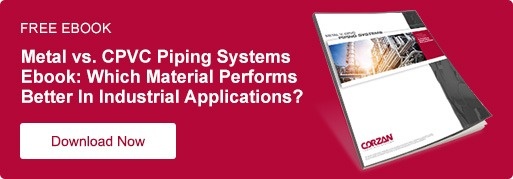How Well Do Metals and Plastics Stand Up to Salts, Brine or Seawater?
When employing salts, brine or other saltwater solutions in industrial processes, the plant’s decision of which piping material greatly impacts lifecycle costs.
Some may see corrosion as a necessary evil when dealing with salts, but proper material selection limits unnecessary repairs, downtime and cost. Over the course of years or decades, this can result in millions of dollars saved in direct expenses and opportunity costs caused by downtime.
How Are Salts Used In Industrial Processing
Across all segments of industrial processing, from power generation to the semiconductor industry, salts may be involved. In general, a salt is a compound resulting from an acid and base reaction. Three common salt compounds are:
Sodium Chloride (Brine) or Seawater
Sodium chloride (NaCl), which is commonly referred to as seawater or brine when dissolved in water, is made from sodium (Na) and chlorine (Cl).
In power generation, sodium chloride is utilized in the ion exchange process of water softening used in feed water production. During wastewater treatment, particularly in coastal regions, piping systems must be able to handle high salinity water before it goes through desalination, which is the process that separates dissolved salts and other minerals from the water. Also, for coastal industrial plants, seawater is an easily available resource that is often used untreated in once-through cooling systems.
Copper Sulfate
Copper sulfate (CuSO4) combines copper (Cu), sulfur (S) and oxygen (O). Functionally, it may be used as a cleaning agent, as it can kill bacteria, algae and other forms of microbial contamination.
In a number of industrial applications, copper sulfate is used in metal finishing for copper plating and is commonly used for semiconductor processing. Copper sulfate is also preferable for metal etching.
Sodium Sulfate
Sodium sulfate (Na2SO4) is a compound comprised of sodium (Na), sulfur (S) and oxygen (O).
Compared to others salts, such as those mentioned above, sodium sulfate may be employed because it is much less corrosive. One case is in the pulp and paper industry for the manufacturing of wood pulp. Also, when dying fabrics in the textile industry, sodium sulfate is used as a less corrosive salt. During the dying process, salts help reduce negative charges and make the dye more easily attract to the fiber, furthering the output of the dye.
Metal’s Compatibility with Salts
Metals are inherently susceptible to corrosion when exposed to water, especially when the water contains dissolved salt. The salt creates an electrolyte solution, which promotes the flow of electrons from one electrode to another.
In the case of metal piping, the salty solution facilitates pipe atoms breaking free of the pipe wall and attaching to free floating ions within the fluid, weakening the material.
To lessen the affect of corrosion, plants must specify alternative materials or alter their process. If metal is elected, an expensive alloy may be employed to help resist corrosion. Throughout processing, additional chemicals may need to be injected to balance the pH and clean the inorganic materials.
Specifying alloys or adding balancing chemicals can be costly and only delay the effects of corrosion—not prevent it. Plants that use metal piping for salt may end up in the never-ending cycle of unnecessary repairs, downtime and installation costs.
Plastics Compatibility with Salts
Conversely, plastics are inert to salts, which means floating ions pass right over the material without any negative effects. All plastics are inherently resistant to all salts. However, CPVC’s ability to work at higher temperatures than cheaper plastics, such as PVC, presents an area of distinction.
Put simply, for applications dealing with salts, plastics should be the first choice to avoid unnecessary repairs.
See what differentiates CPVC piping from PVC piping in this blog post.
How Do CPVC and Metal Compare In Other Categories?
When it comes to salts, CPVC has a clear advantage. However, how do the two potential industrial materials stack up in other areas of corrosion, scaling, installed cost, temperature and more? Our product and engineering team takes a deeper look in the ebook, Metal v. CPVC Piping Systems.


